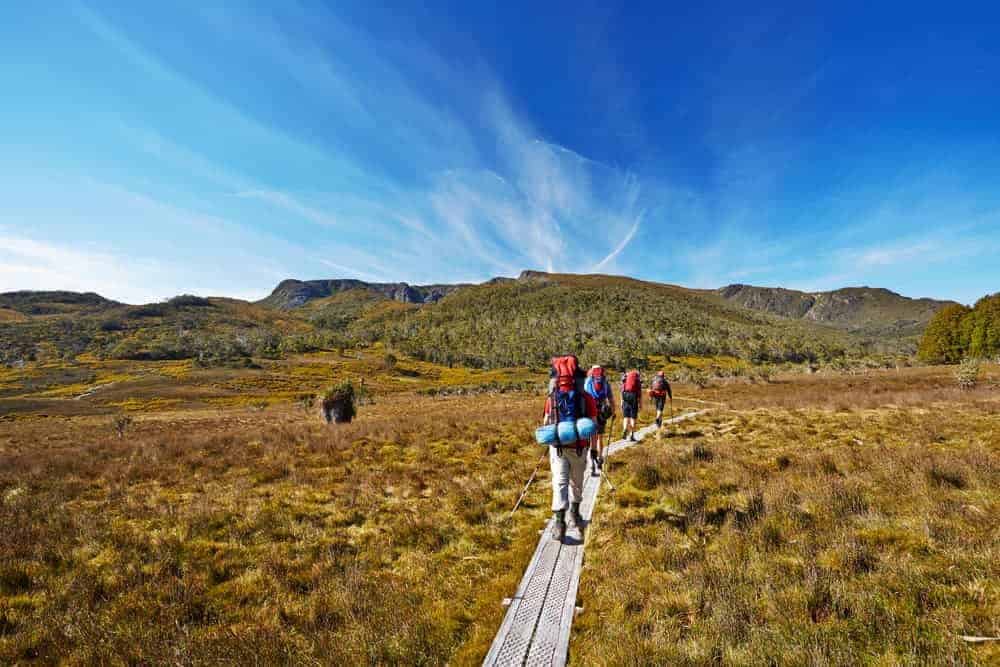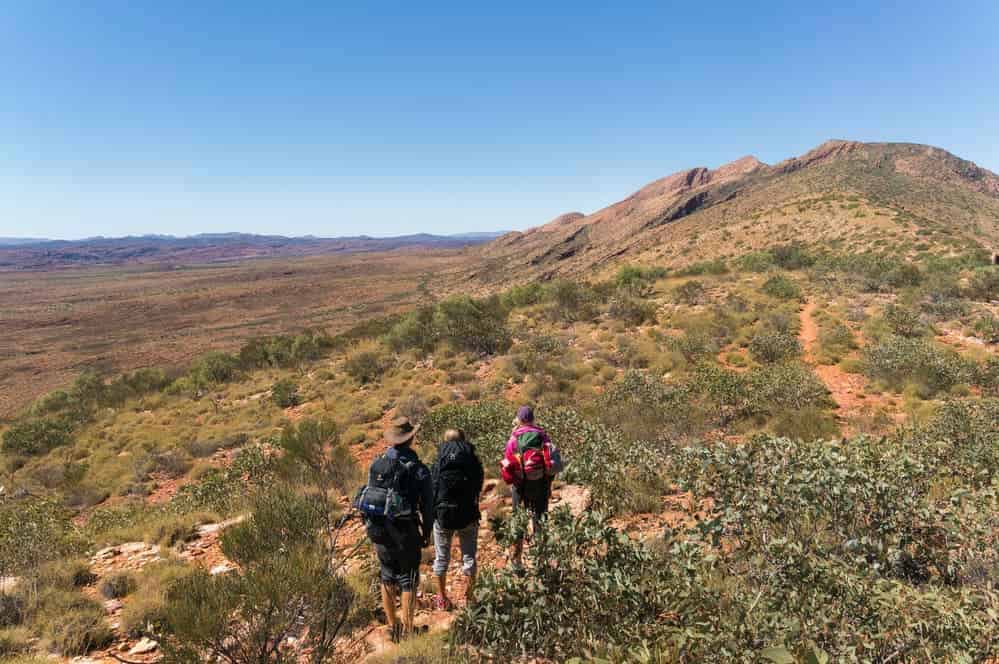When it comes to hiking, the land down under has so much to offer. Be it a half-day adventure for first-timers or a multi-day trek for seasoned hikers, Australia’s best hiking trails promise astounding landscapes, diverse wildlife and broken-in boots. So, if you’re in the country and love trekking as much as I do, visit one of these highly recommended hiking trails for a trip that’s one for the books.
1. Most Epic: Larapinta Trail, NT
If you like hiking in Australia and visiting historical sites, the Larapinta Trail will not disappoint. The track, which follows the West MacDonnell Ranges, boasts ancient rock formation sculpted by weather elements.
Included in the world’s top 20, it’s one of the best hiking trails you can visit! Here, you’ll be walking on steep terrains and seeing tall red rock mountains. Along the way, you can visit attractions like Ellery Creek Big Hole’s refreshing waterholes, towering cliffs of Simpsons Gap and Glen Helen Gorge’s local wildlife.
The entire trek is not for beginners, but bushwalkers may opt for shorter tracks with varying length and difficulty. Campgrounds with water supply, tent sites, picnic tables free gas barbecues are also available. You can also avail fully guided tours. But, if you’re setting off on your own, make sure to notify the authorities.
- Distance: 223km
- Length: 16 to 20 days
- Grade: 3 to 4
- Best time: April to September
- Tip: Take on this world-renowned trek during the cooler months. Make sure to prepare well for this challenging hike, particularly food drops.
2. Best Coastal Hike: Cape to Cape Track, WA
Put your love for sandy beaches and trail hiking together by visiting the Cape to Cape Track, about 260km south of Perth. This route runs along the Margaret River coast from Cape Naturaliste to Cape Leeuwin (hence the name).
It’s a paradise full of pristine surf beaches, sea cliffs, cave networks and astounding karri trees at Boranup Forest. What I like about this track is that there are always exciting things to see: dolphins at any time of the year, migrating humpback whales from June to September and wildflowers in the spring at Contos Beach.
It will be quite a feat to finish the whole track, but half-day or day walks are available. There’s a wide range of campsites as well. Some even offer luxurious accommodations for hikers who wanted to take it easy after a long walk. There’s road access on both ends of the trail, and companies can avail guided tours.
- Distance: 135km
- Length: 6 to 7 days
- Grade: 4
- Best time: March to May or September to November
- Tip: Try to avoid this track during summer as the risk of fire danger due to extreme heat is high. Also, potable water may be hard to come by, so make sure to pack enough.
3. Most Fascinating: Fraser Island Great Walk, QLD
Fraser Island is the largest sand island in the world. A World Heritage-listed site, it’s also one of the most peculiar. It has rainforests that grow on the sand and rise to 200m plus rain-filled lakes formed in dunes.
Its Great Walk starts from Dilli Village to Happy Valley. Here, you’ll be passing by beautiful locations. Take a dip on Lake McKenzie’s blue waters or see the deepest lake on the island, Lake Wabby. You can also walk along Eli Creek and visit the towering satinay trees in the Valley of the Giants. Fraser Island sure has something for the nature-loving and adventurous types.
Make sure to drop by the Central Station and learn more about the island’s history and ecology. If you’re short on time, there are smaller segments for you to try. Camps and camping equipment are also available along the route, or you may opt to stay in private guesthouses and villas at the Kingfisher Bay Resort.
- Distance: 90km
- Length: 8 days
- Grade: 4
- Best time: April to September
- Tip: Make sure to secure camping permits and book campsites in advance. Gear up and bring your essentials as island villages are quite distant from one another. And watch out for dingos!
4. Most Intense: Australian Alps Walking Track, VIC
Commonly regarded as the mountain lover’s trail, the Australian Alps Walking Track (AAWT) begins at Walhalla, VIC, and runs to Tharwa, ACT. It’s the best long-distance walking trail that features stunning but brutal terrains.
If you’re an experienced walker, and perhaps a born daredevil, then the AAWT is for you. Be ready to bushwalk on rugged alpine tracks, climb the highest mountains and cross grassy plains. Along the way, you’ll be able to see astounding snow gum woodlands and native forests.
Taking on shorter walk sections is a popular choice among trekkers who cannot finish the entire trail. Some of the available tracks include the Mount Kosciuszko, Bogong High Plains, Baw Baw Plateau and Cross Cut Saw.
- Distance: 655km
- Length: 45 to 60 days
- Grade: 4 to 5
- Best time: November to May
- Tip: Stunning but fiercely challenging, this trail has rough terrains at certain points that may not suit beginners. As this track takes several weeks, you’ll likely encounter weather changes from dry to wet without warning. So, make sure to prepare well or visit it during the warmer months.
5. Premier Alpine Hike: The Overland Track, TAS
The Overland Track is one of the iconic walking trails in Tasmania. This route starts at World Heritage-listed Cradle Mountain and ends at Australia’s deepest lake, Lake St Clair. It’s one of the best hiking trails in Australia and has almost everything nature has to offer, including moorlands, granite peaks, rainforests, waterfalls and alpine fields full of wildflowers. Its campgrounds and huts are also home to Tasmania’s diverse wildlife, from wombats to wallabies to echidnas. Just be wary of brazen possums and currawongs that might steal your food!
Overland Track requires high fitness levels and ample preparation. Tasmania’s ever-changing weather can shift from cold to wet even in the middle of summer, so pack your rain gear. The track also offers optional side trips, which can stretch your trip. A side trip to Mount Ossa, the highest peak in Tasmania, is highly recommended.
Make sure to bring the right clothing, first aid kit and enough food and water before setting out. In case of weather changes, don’t push on beyond your limits. Also, log your movements on the logbooks found on the camping huts so that park staff can easily track you in case of an emergency.
- Distance: 65km
- Length: 6 days
- Grade: 4
- Best time: December to April
- Tip: About half of the trek features elevated tracks (about 1000m above sea level) in a remote area, so best be prepared for the capricious weather. If you plan to hike between June and September, you have to be an experienced trekker with high-level winter walking navigation skills.
6. Best Sensory Walk: Blue Gum Forest, NSW
Back in the 1930s, the Blue Gum Forest was almost destroyed if not for local bushwalkers who saved, bought and preserved the land. Thanks to them, hikers can come to the Blue Mountains and see impressive eucalyptus trees, which give the forest its distinct hue and fragrance. The valleys, swamps and birds, like the cockatoo, make the forest a feast for the senses. However, while the trail is short, starting at Perry’s Lookdown, it also has cliff lines, so be careful.
If you wish to stay overnight, you can pitch your tent at the Acacia Flats on the bottom of Grose Valley. This campground is only 500m away from the forest and surrounded by acacia and blue gum trees. There’s a pit toilet to use, tree logs to sit on and water from Govetts Creek. It’s one of the best hiking trails for people who only have the weekends to spend time with nature!
- Distance: 4km
- Length: 5 hours
- Grade: 4
- Tip: For safety, fill in a free trip intention form to inform your emergency contact where you are going. It’s also a good idea to bring a compass, GPS, personal locator beacon (PLB) and topographic map.
- How to Clean and Care for Your Sleeping Bag - January 6, 2022
- 6 Best Things to Do in Perth for Free - December 3, 2021
- Swag vs Tent: Which One is Better? - November 5, 2021



